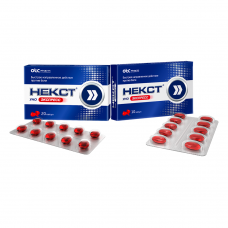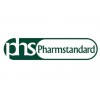Expiration date: 07/2026
Indications:
Apply for headache, migraine, toothache, painful menstruation, neuralgia, back pain, muscle and rheumatic pain; with feverish conditions for flu and colds.
Designed for symptomatic therapy, reduce pain and inflammation at the time of use, the progression of the disease does not affect.
Side effect:
In applying the drug Nekst® UNO Express within 2-3 days of side effects are almost not observed.
In the case of long-term use, the following side effects may occur:
- the gastro-intestinal tract (GIT): NSAID gastropathy (abdominal pain, heartburn, diarrhea, bloating, pain and discomfort in the epigastric region), ulceration of the mucous membrane of the gastrointestinal tract (in some cases complicated by perforation and bleeding); irritation, dryness of the mucosa of the oral cavity or pain in the mouth, pitting mucous membrane of the gums, aphthous stomatitis, pancreatitis, constipation, indigestion, nausea, loss of appetite, vomiting, hepatitis;
- from the respiratory system: shortness of breath, bronchospasm, exacerbation of bronchial asthma;
- hearing impairment: hearing loss, ringing or tinnitus;
- of the Central and peripheral nervous system: insomnia, anxiety, nervousness and irritability, psychomotor agitation, depression, confusion, hallucinations, rarely-aseptic meningitis (more often in patients with autoimmune diseases), headache, dizziness, drowsiness;
- from the cardiovascular system: development or aggravation of heart failure, tachycardia, increased blood PRESSURE;
- from the urinary system: acute renal failure, allergic nephritis, nephrotic syndrome (edema), polyuria, cystitis;
- from the hematopoietic organs: hemolytic anemia, aplastic anemia, thrombocytopenia and thrombocytopenic purpura, agranulocytosis, leukopenia, pancytopenia;
- from the organs of vision: reversible toxic amblyopia, unclear vision or double vision, dryness and irritation of the eyes, swelling of the conjunctiva and eyelids (allergic Genesis). scotoma. color vision disorders;
- allergic reactions: skin rash (usually erythematous, urticaria), itching, Quincke edema, anaphylactoid reactions, anaphylactic shock, bronchospasm, fever, multiform exudative erythema (including Stevens-Johnson syndrome), toxic epidermal necrolysis (Lyell's syndrome), eosinophilia, allergic rhinitis;
- other: increased sweating.
The risk of developing ulcerations of the mucous membrane of the gastrointestinal tract, bleeding (gastro-intestinal, gingival, uterine, hemorrhoidal), visual impairment (violation of color vision, scotoma, amblyopia) increases with prolonged use at high doses.
If side effects occur, you should stop taking the drug and consult a doctor.
Laboratory indicators:
- bleeding time (may increase);
- the concentration of glucose in serum (may be reduced);
- creatinine clearance (may decrease);
- the hematocrit or hemoglobin (may be reduced);
- serum creatinine concentration (may increase);
- activity of "hepatic" transaminases (may increase).
Overdose:
Symptoms: abdominal pain, nausea, vomiting, lethargy, drowsiness, depression, headache, tinnitus, metabolic acidosis, coma, acute renal failure, decreased blood pressure, bradycardia, tachycardia, atrial fibrillation, respiratory arrest.
Treatment: gastric lavage (only for an hour after administration), activated charcoal, alkaline drink, forced diuresis, symptomatic therapy.
Interaction:
Inductors of microsomal oxidation (phenytoin, ethanol, barbiturates, rifampicin, phenylbutazone, tricyclic antidepressants) increase the production of hydroxylated active metabolites of ibuprofen, increasing the risk of severe hepatotoxic reactions.
Microsomal oxidation inhibitors reduce the risk of hepatotoxic action of ibuprofen.
Ibuprofen reduces the antihypertensive effect of antihypertensive drugs (ACE inhibitors, blockers slow calcium channels, etc.), natriuretic and diuretic efficacy of furosemide and hydrochlorothiazide; reduces the effectiveness of uricosuric drugs, enhances the ulcerogenic action of glucocorticoids, colchicine, ethanol; enhances the effect of oral hypoglycemic agents and insulin; increases the concentration in blood of digoxin, drugs lithium and methotrexate.
Ibuprofen increases the undesirable effect of estrogens when used together.
Antacids and cholestyramine reduce the absorption of ibuprofen.
Caffeine enhances the analgesic effect of ibuprofen.
With the simultaneous appointment of ibuprofen reduces anti-inflammatory and antiplatelet action of acetylsalicylic acid (possible increase in the frequency of acute coronary insufficiency in patients receiving small doses of acetylsalicylic acid as an antiplatelet agent, after the beginning of ibuprofen administration).
In appointment with anticoagulant and thrombolytic drugs (alteplase, streptokinase. urokinase) can also increase the risk of bleeding.
In a joint application of ibuprofen and cefamandole, cefoperazone, cefotetan. valproic acid increases the frequency of gipoprotrombinemii.
Myelotoxic drugs increase the manifestations of hematotoxicity of the drug.
Cyclosporine and gold preparations increase the effect of ibuprofen on prostaglandin synthesis in the kidneys, which manifests an increase in nephrotoxicity.
Ibuprofen increases plasma concentration of cyclosporine and the probability of its hepatotoxic effects.
Drugs that block tubular secretion, reduce the excretion and increase plasma concentrations of ibuprofen.
Ibuprofen can reduce the effectiveness of mifepristone, so ibuprofen should be started no earlier than 8-12 days after taking mifepristone.
With the simultaneous appointment of ibuprofen and tacrolimus may increase the risk of nephrotoxicity.
Simultaneous use of ibuprofen and zidovudine can lead to increased hematological toxicity.
There is evidence of an increased risk of haemarthrosis and haematoma in HIV-positive patients with hemophilia treated with the joint treatment with zidovudine and ibuprofen.
Patients receiving joint treatment with ibuprofen and quinolone antibiotics may increase the risk of seizures.
Composition:
1 capsule contains:
Active ingredient: ibuprofen-200,000 mg.
Excipients: ?-tocopherol acetate-0.372 mg, povidone 17 PF-30,000 mg, macrogol 600-414,628 mg.
The composition of the shell capsules: gelatin, sorbitol solution rekristallizatsiya, glycerol, methyl parahydroxybenzoate, purified water, dye red the charming E-129.


